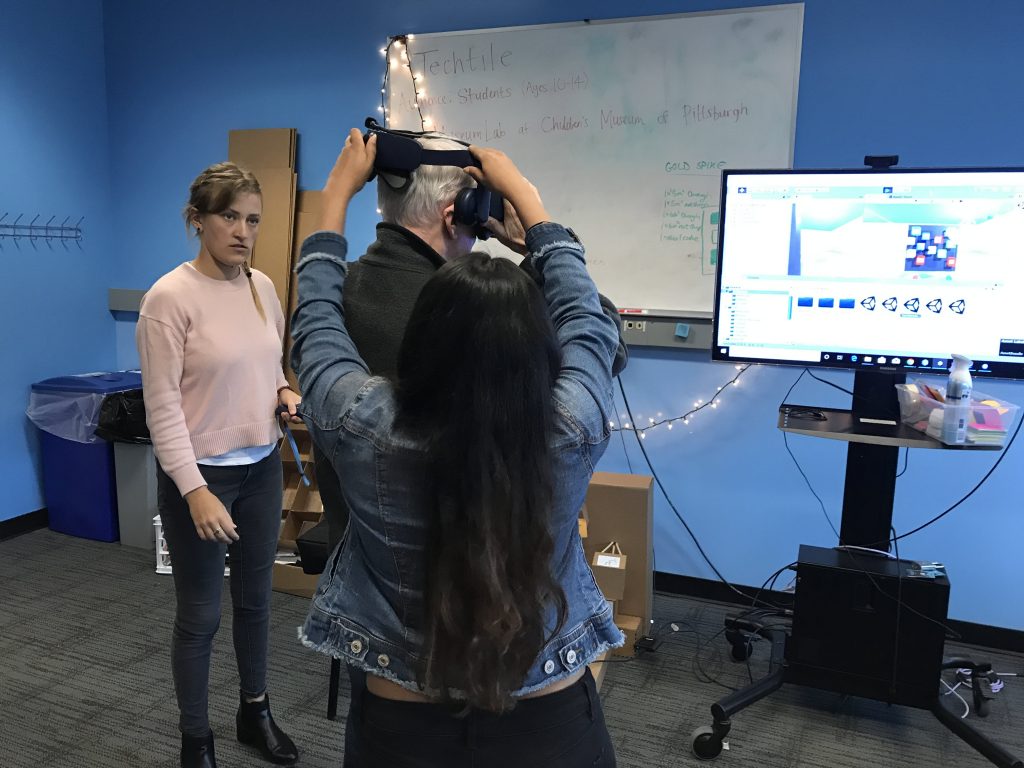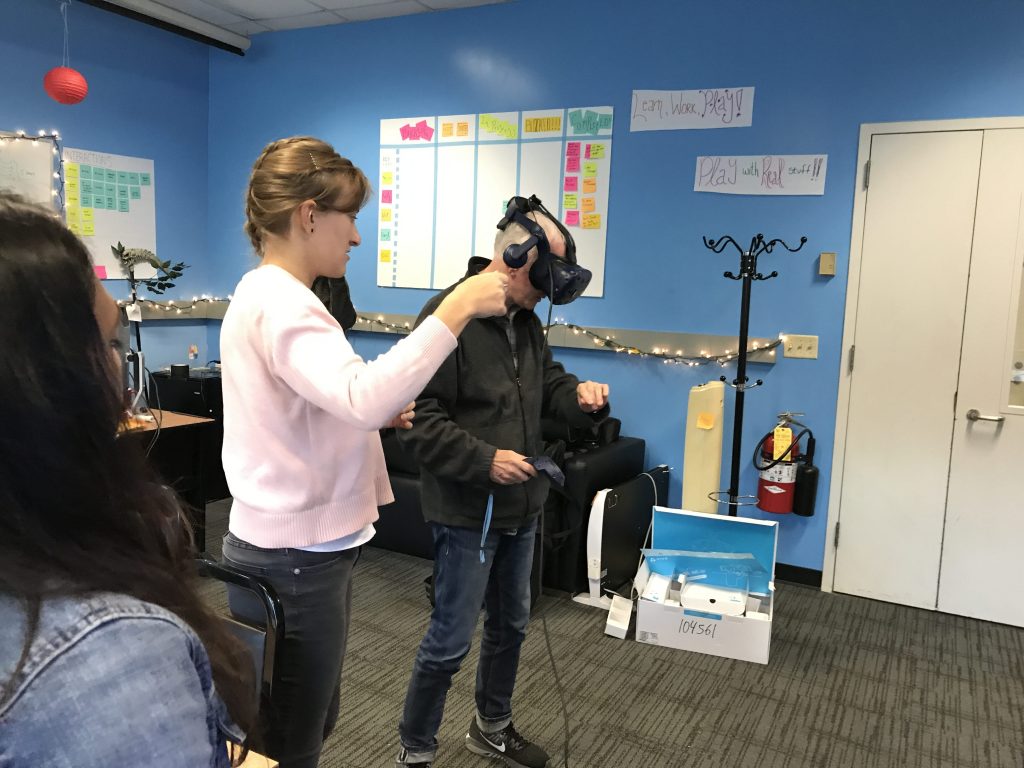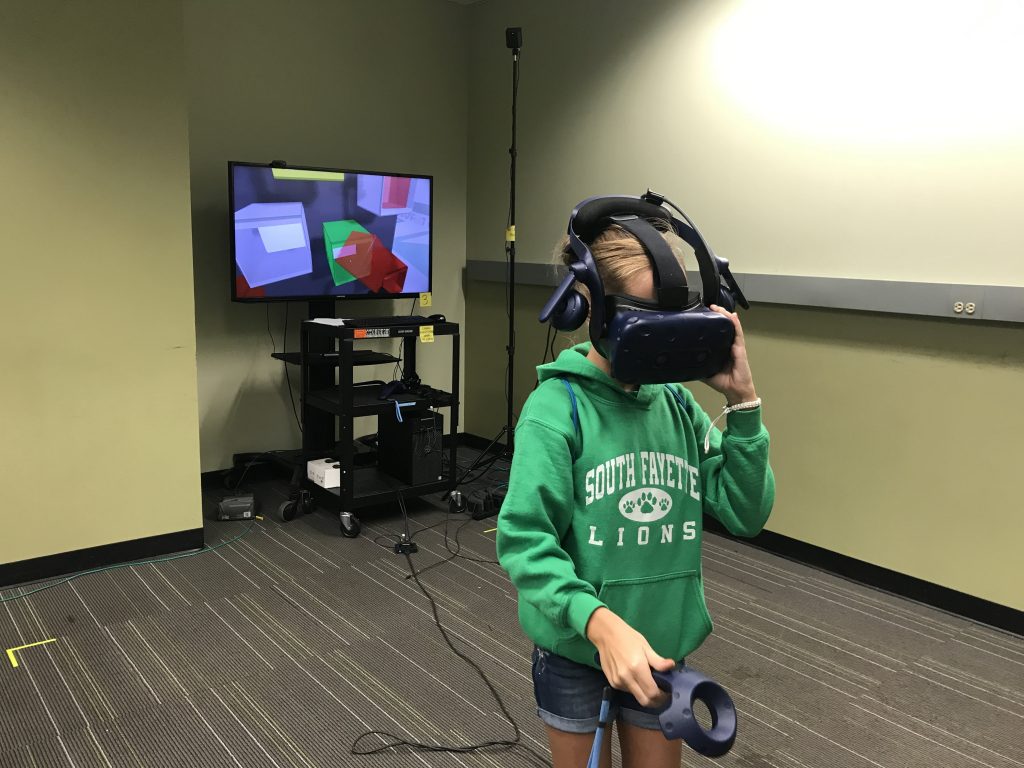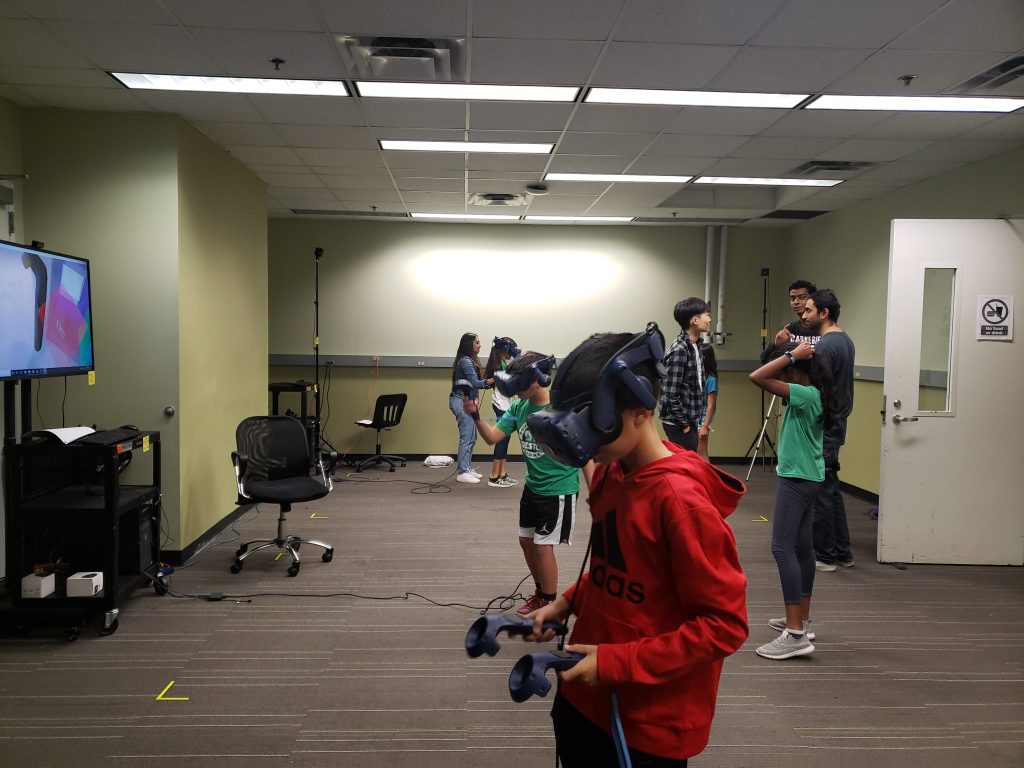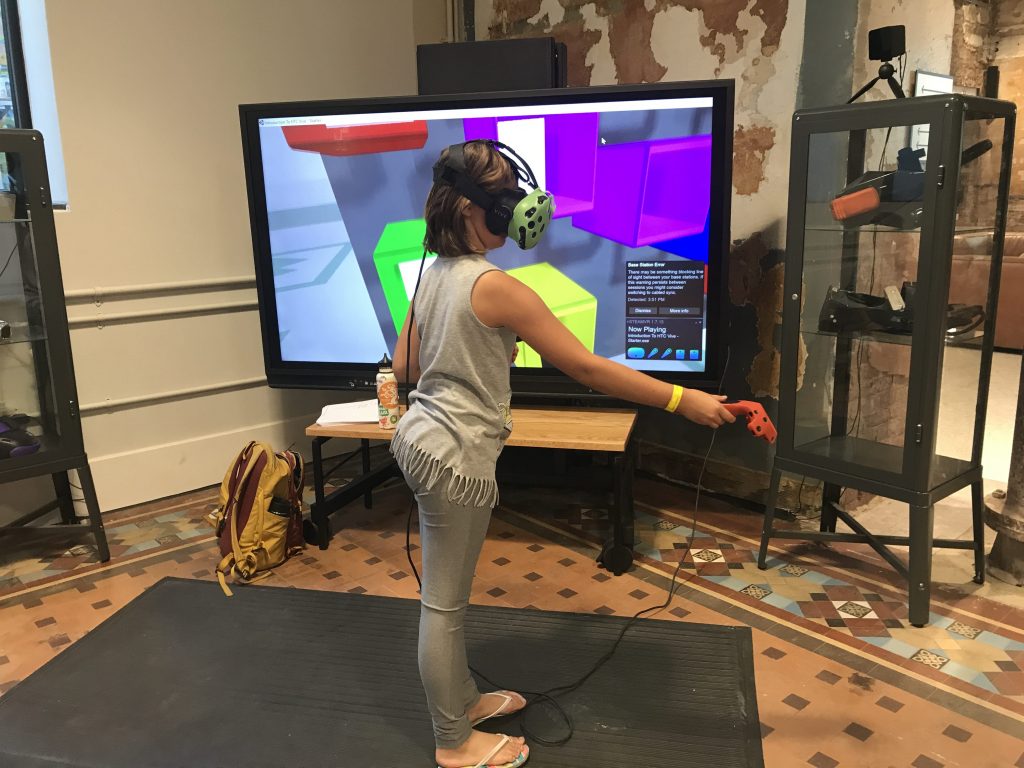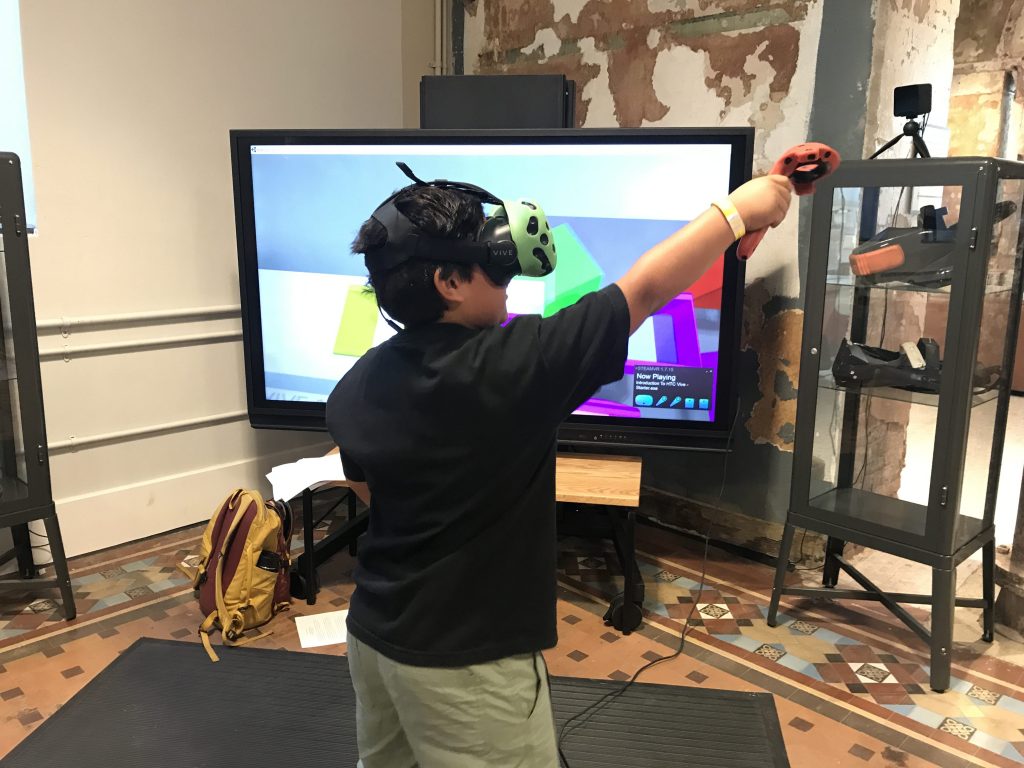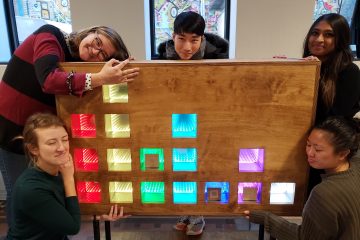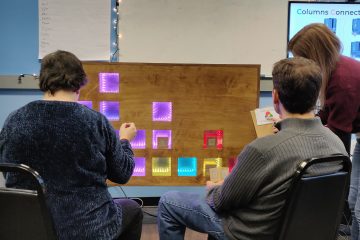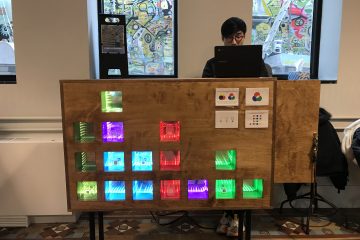Week 5
This week was jam packed with fabricating, designing, interviews, meetings, and playtesting.
Fabrication
Nidhi and Marissa took the lead on fabricating our gold spike, which we plan to have done by the end of Week 5. This will be a small prototype that has five working cubbies that will be able to sense RFID tags in a cube and change colors. We’re experimenting with:
- Size of the cubbies (how big does the cubby need to be to allow the light to show and for easy access and removal of blocks?)
- Type of recessing (all the way through the installation vs. having a back)
- LED light arrangement (back of the cubby vs. all the way around)
- RFID tags and receivers (does this work?)
Nidhi worked on the hardware, figuring out the layout of LED lights; how to wire, power, and send info to each cubby. She also taught us all how to solder new components for the prototype.
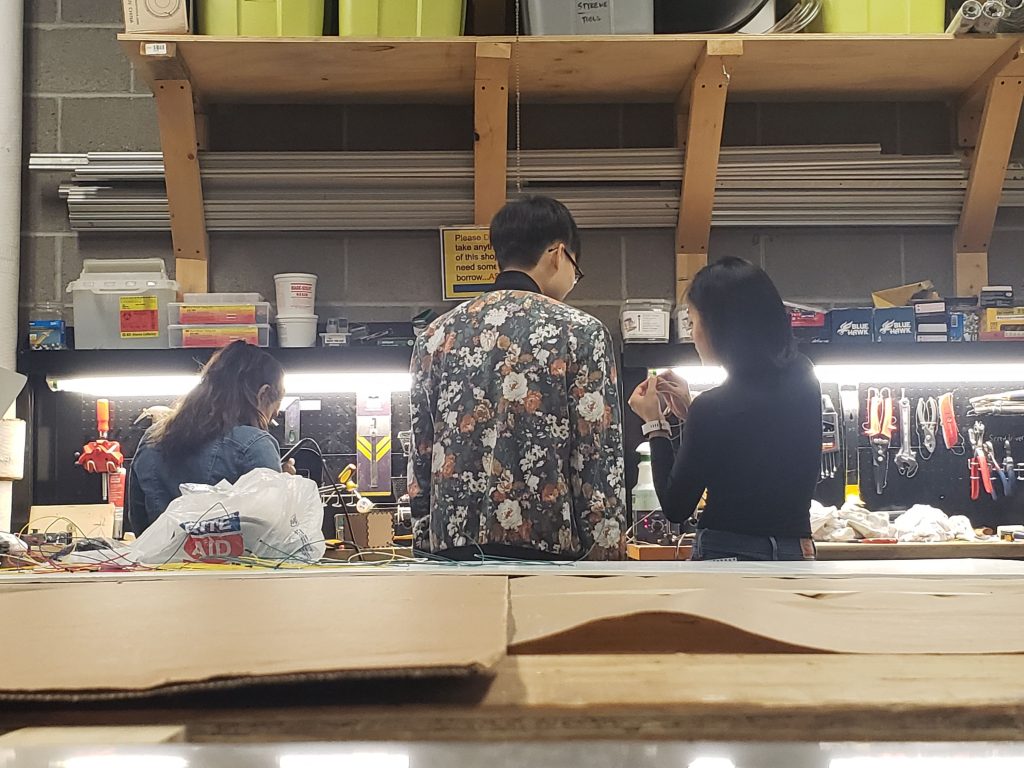
Marissa worked on the design and assembly of the physical cubbies with Emily. They got the chance to use the Shaper Origin at the MuseumLab, which is a really amazing tool. It overlays your design file onto the piece that you want to cut, and allows for precise freehand cutting.
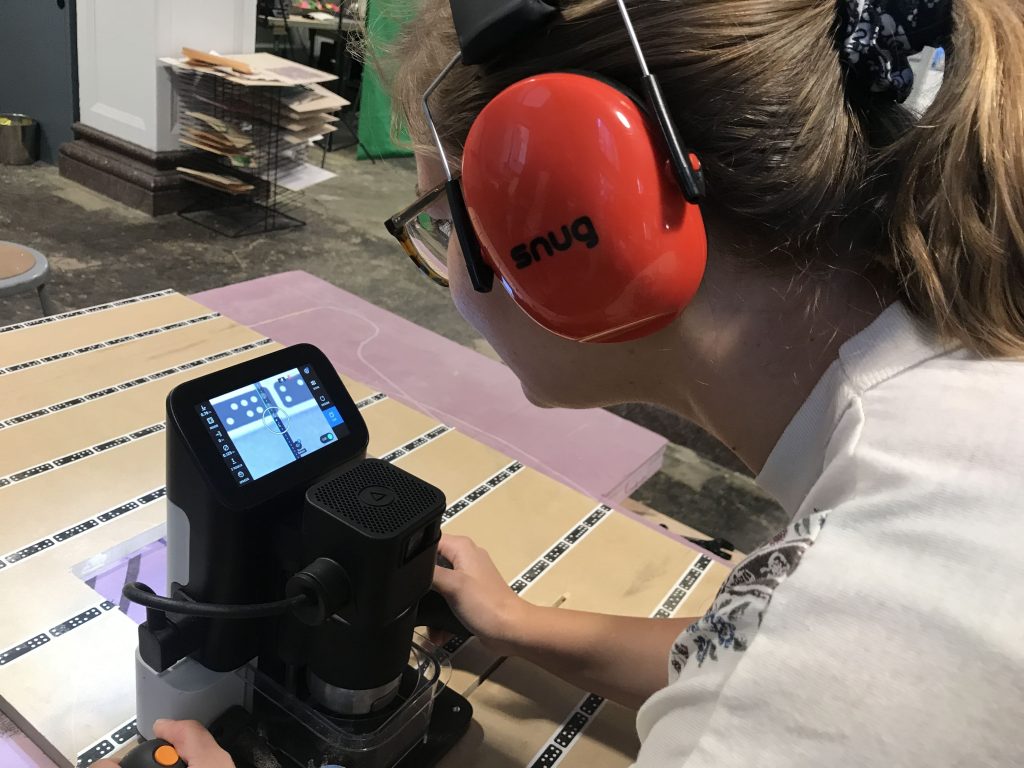
This gold spike will allow us to figure out the design challenges in fabrication and provide a physical prototype to begin playtesting with.
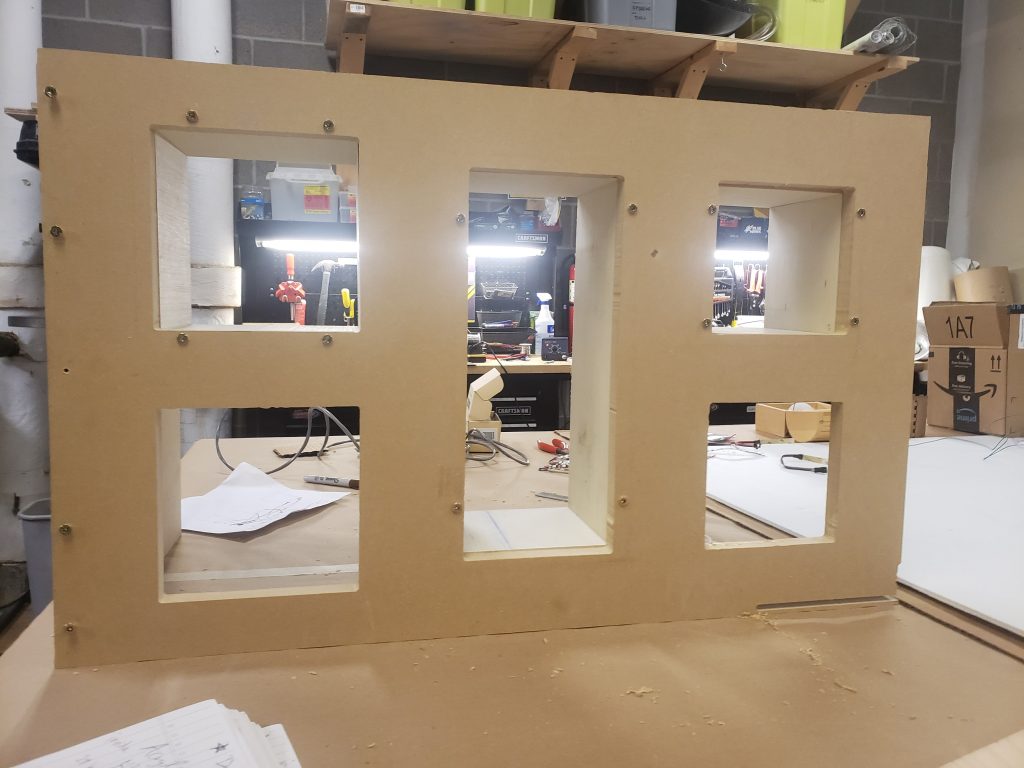
Front 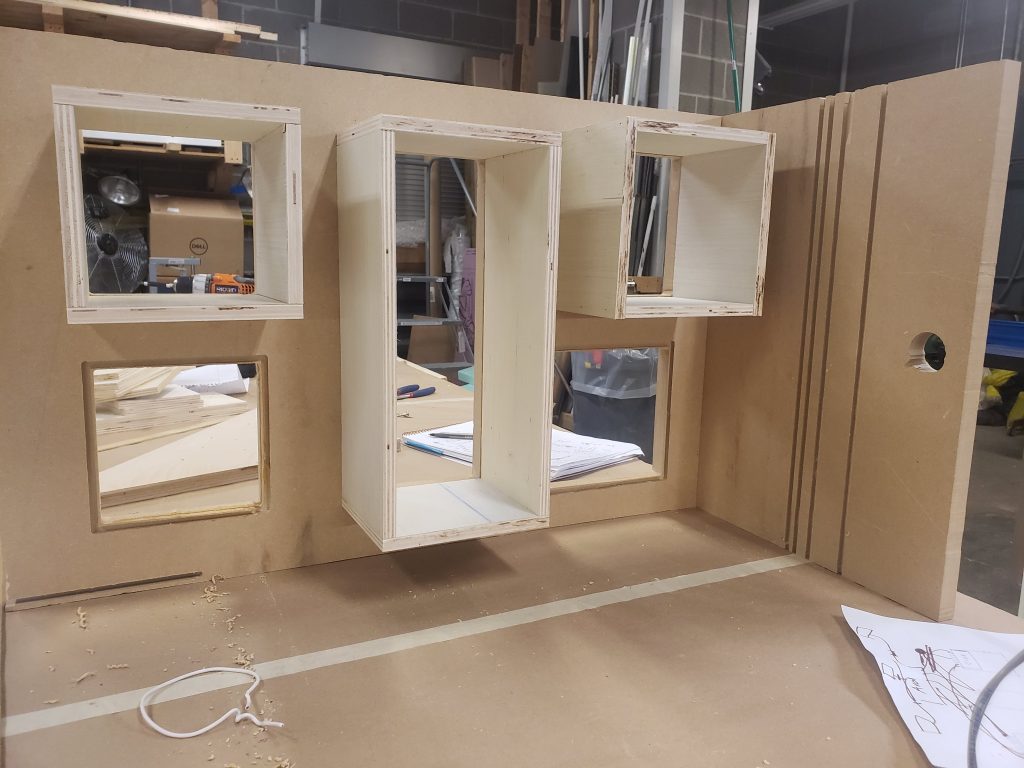
Back
Research
Our main feedback from quarters was that we really needed to get into the mindset of our demographic. We are still in the middle of figuring out the logistics of playtesting and working with the Manchester Academic Charter School (MACs). Given that we didn’t want to put everything on halt, we started to reach out to other middle school teachers to collect information on how to work with middle school students. While it is definitely preferable to talk with middle school students, this was the next best intermediate step that we could take immediately.
Through Mike, we reached out to Amy Besterman a 5th Grade teacher at Avonworth Elementary School who specializes in Math & Science. Marissa and I additionally reached out to our teacher contacts (as we both used to work in informal STEM education environments). We interviewed:
- MK Conway, Special Education Coordinator at Roxbury Prep (Demographic: 50% African American, 45% Latinx, 2% Vietnamese, 2% White; 100% Qualified for Free and Reduced Lunch)
- Gina Varamo, former Assistant Director of Youth Programs for Science Club for Girls (100% Women, Underrepresented in STEM: African American, Nepali, Asian, Latinx; 80% Qualified for Free or Reduce Lunch)
- Megan [ Marissa’s contact]
Synthesizing the information from the interviews, here were some of the main themes:
- Peer influence is huge, especially as they transfer from 5th to 6th
- 5th grade kids love to make their teachers proud and are people pleasing
- 6th and above care less about what teachers think, but what their peers think
- Relevancy/framing is important
- Connecting to personal life or using humor
- Get kids to buy-in
- What should they take away?
- How can they connect this to their personal lives
- Application to the real world
- Kids are naturally curious! Create an environment where they can be naturally engaged
- Positive feedback creates good momentum, that you’re grasping this concept
- Negative feedback can create resentment, kids will shut down if things are hard or inaccessible
- We overage kids sometimes, they’re just young kids who are caught in this thing to be older
- We de-emphasize how bright they are
- Kids like choice!
- When we give them opportunities to choose things rather than telling them what to do
- Don’t like rules
- Give them freedom to make as many decisions on their own
- Kids like:
- modern technology
- anything that lights up
- anything that they can touch
- anything that they can build with their hands
- art
- music
- talking
- movement
- Being able to teach adult things!
- Typical middle school students without any disability can engage for 10-15 minutes, that’s typically the goal in classrooms
When we presented our idea, these were some of their comments:
- Described the process that we were trying to get the middle schoolers to think as inquiry-based or discovery learning
- They thought that middle school students would definitely like it because it lights up and has technology
- They liked that it offered opportunities for different types of learners and for collaboration
- They said to focus on the customization and expression part of the experience to allow for curiosity with inquiry
- They stressed staying away from competitiveness because this would hinder exploration
- They asked if it was possible to provide some sort of description or card to explain the experience to scaffold learning
These interviews were really helpful in determining our player experience. We feel like we’re on the right path with focusing on customization and expression. We’ll have to add in more positive feedback in the experience and figure out how to explain the relevancy of this color mixing logic to students’ lives.
Meetings
On Wednesday, we met with Universal Creative and shared what we’ve been working on. They asked us to think about:
- Challenge? Competition?
- What’s the game?
- Getting into the middle school students heads, asking what they like
They shared that at Universal they undergo the same process of prototyping. First with cardboard/paper prototyping and then building with VR to figure out if it is fun. At that point, they can pitch the idea in VR and get the money to build. It was cool to be able to compare our processes for prototyping with a larger company who creates location-based experiences.
On Thursday, we met with Dr. Maggie Hannan, Simon Initiative Associate Director for K-12 to discuss how we can work together in our partnership with the MuseumLab and CMU. Her role in the Simon Initiative is to build networks and find ways to bring together complementary sets of expertise. Often times amazing technology is designed at the ETC, but then there is no longevity of the experience and no diversity in the users it gets to. We discussed opportunities to using visitor perspectives to build experiences over the long term.
Her notes about our design:
- Really nice way to spur engagement and fascination in visitors
- Agency and kinesthetic is perfect for space
- Color mixing is so relatable
- Being able to move and build and interact in a way that is a continual process of experimentation and fabrication
- Design is elegant, don’t clutter it up
She challenged us to think about:
- A way to help visitors who interact with this capture their hypothesis?
- How do we scaffold learning? Help them get unstuck, offering opportunities to learn about logic or why it might be interesting?
- How do you gently mediate and guide a visitor through this?
- How do we measure how playtesters are interacting?
Following our meeting, Maggie will reach out to her contacts at MACs and in the Northside community to see if we can get access to more diverse playtesters. In addition, she shared a resource from The Activation Lab that has a scale of measure for informal STEM learning.
Right after, we met with Anthony Daniels and were able to show a few versions of our VR prototype! He asked us to take photos for his wife for his instagram. Of course we obliged and took many. He was excited about the possibilities of our experience and challenged us to think about why the students should care. He felt that the concept was intuitive and translated well into the space, and that the VR was a nice way to mock-up the experience and test.
On Friday, we had our last meeting of the week with Maria Montenegro, one of the Senior Engineers at Magic Leap focusing on rapid prototyping in the field of computer vision and artificial intelligence (also an ETC alum!). Maria was excited about our pitch as she has a background in building interactive installations (she recently built one a Burning Man!), and because she tried to pitch similar ideas while she was at the ETC.
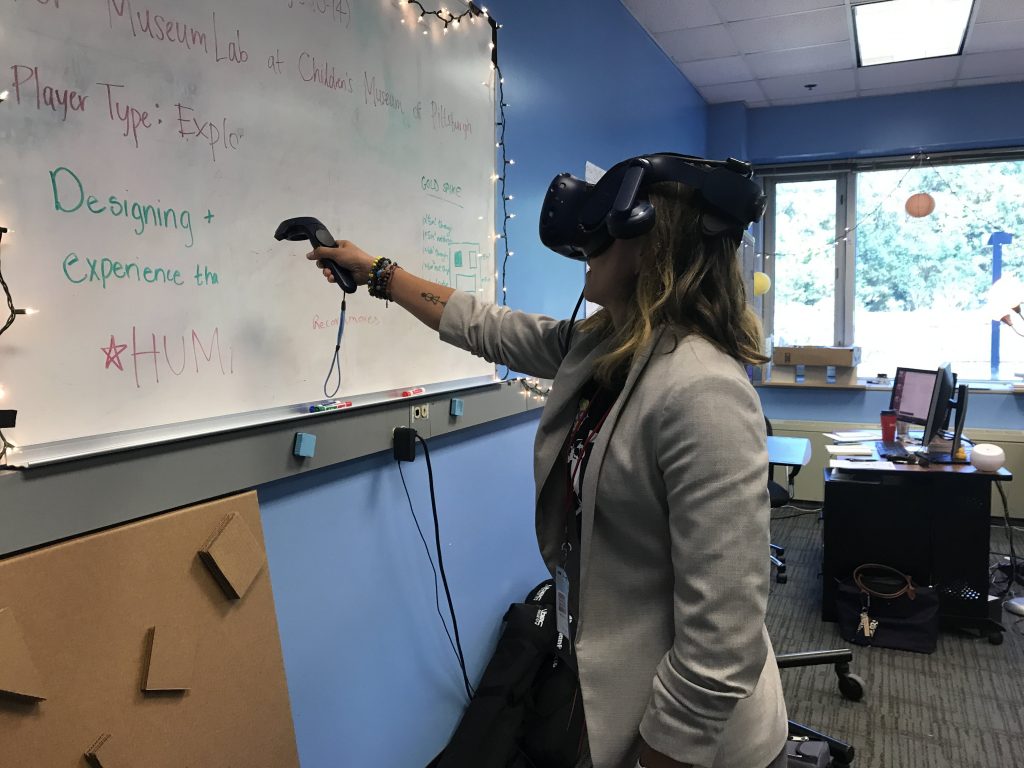
Her suggestions:
- Could we explore infinity mirrors in the cubbies?
- Unleash secret hidden interactions
- Build in negative reinforcement for things that you don’t want guests to do. For example, putting two blocks in one cubby –> tell it to stop! go home!
- Positive feedback to encourage guest to leave cubes in the wall: Does everything vibrates when all the cubes in?
- We need to swap quick to our physical prototype and see what they do in real life
- One main Arduino controlling LEDS
- Small Arduinos for all the RFIDS
- All RFIDS communicate with the main Arduino via radio or wifi chip or even analog (might need a raspberry pi with 2G of RAM)
- Break up installation into smaller pieces that are portable
- Make it in sets, perfect one cube. Then once you know how this is going to be wired, iterate on the one. Perfect on mechanic, make sure the mechanic is good and then replicate
She gave us a lot of good suggestions for the design and made it sound like a piece of cake. She felt like it was feasible for us to install and have time to iterate. It made us feel a lot more confident about our process.
Playtesting
For this playtest we:
- Simplified number of variables: only unknown variable is the property of the blocks, the wall reacts to the box’s properties
- Tried new logic: will an HSL spectrum be more intuitive than RGB?
- Do they figure it out?
- Are they able to use logic to be expressive?
- Should the cubes keep changing value until the cube is removed?
We had three versions for our VR prototype:
- Version 1: RGB Additive w/ Marked blocks
- 1 cubby type: singular and neutral
- 3 block types: R255, G255, B55
- Color property of block changes the color of the cubby
- Cubby retains color when block is removed
- Cubbies add the RGB value to what they currently possess allowing for mixing of colors
- Once all RGB values are at 255, the cubby returns to value R0, G0, B0
- Version 2: RGB Additive – Fluctuating
- 1 cubby type: singular and neutral
- 3 block types: R255, G255, B55
- Color property of block changes the color of the cubby – fluctuates in color (0→ 255)
- Cubby retains color when box is removed
- Cubbies add the RGB value to what they currently possess allowing for mixing of colors
- Version 3: HSL Fluctuating blocks
- 1 cubby type: singular and neutral
- 3 block types: Hue, Saturation, Light
- When block is placed in, property FLUCTUATES (H0 → 360, S25 → 100, L25 → 100)*
- *Note: these values were decided based upon what was visible in Unity when these property values were changed
- Property of the block manipulates corresponding property of the cubby
- Cubby retains color when block is removed
We also wanted to know:
- Are guests engaged?
- What is the pattern of play?
- Do we see thoughtful placement?
- Do we see random placement?
- Length of engagement?
- What is the pattern of play?
- Do guests want a goal?
- What do guests expect?
- What are guests trying to do?
- What do guests want to do?
On Wednesday, we went to the MuseumLab to playtest during our arranged weekly time. However, the afterschool program had not started yet so there were no guests in the space (one 8 year old boy tried the headset for 30 seconds before his mother made him leave). Unfortunately, we were unable to gather any data from this playtest.
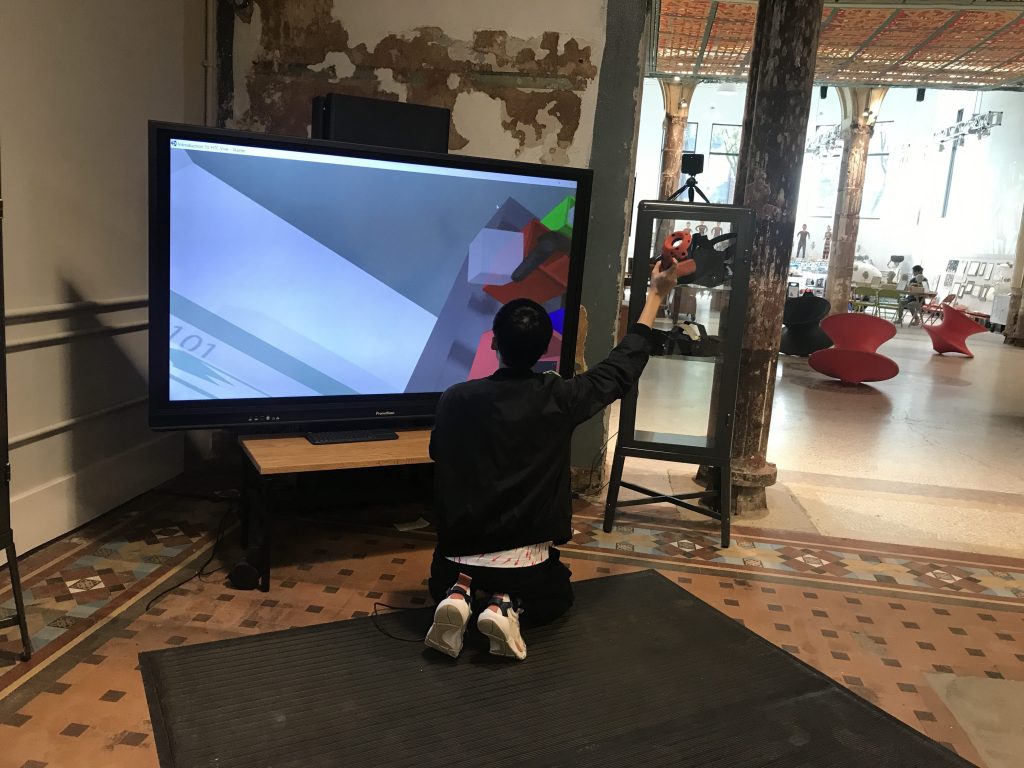
Luckily, students happened to be coming for a Community Tour on Friday, so we had them stop by to playtest. We playtested with twenty-six 5th graders from South Fayette Middle School. We only were allowed 30 minutes to playtest per group of 13 students, so we were only able to run each student through one of our three designs and ask them some follow-up questions. Of course, per our luck, there was a power outage right before we were able to test with the second group. We only had 15 minutes to playtest with the last 13 students, which barely gave us enough time to run them through one version and ask questions. We collected data via surveys and interviews.
We were able to head to the MuseumLab again on Friday to playtest in the afternoon. There were four students in the space that were able to playtest. Luckily 3 of the 4 were in our demographic. We surveyed/interviewed these students and compiled their data into the summary below.
Overall, we found that students enjoyed the experience. However, we couldn’t tell if this was just because they were fascinated by the VR demo. Most of these students had never done VR before so they were more excited about what they could do (i.e. their comments were mostly about stacking and throwing blocks). Even though we prefaced their experience by explaining what we were trying to build and that this was just a prototype in virtual reality (the final will be physical and in the real world), they would forget because they were immersed in the VR world and distracted. We didn’t want to lead them and ask them to focus on just interacting with the blocks and the wall. Because we wanted to know if the experience was engaging enough and offered enough affordances (which apparently it did not). So unfortunately, as a result a lot of our feedback was about improving the VR experience. Comments like:
- The cord wasn’t long enough. I wish there was a cord and it was connected.
- The most frustrating moment was when the blocks break apart when I put another block on
- The most frustrating moment was when I kept knocking over the blocks!
- The mask kept falling off
We will have to transfer to a physical prototype to test as soon as we can. This will provide us with more accurate data.
But not all was lost! We did learn a lot from this playtest:
- Students liked the color changing
- They liked putting the blocks in and out of the cubbies
- They found it satisfying and exciting when the cubbies reacted in the way that they expected
From the abbreviated Game Experience Questionnaire that we had them fill out, we found that:
- The experience scored high (4-5):
- I felt like it was fun
- I felt successful
- I felt imaginative
- I felt like I could explore
- I enjoyed it
- Medium (3):
- I found it aesthetically pleasing
- I felt skillful
- Low (1-2):
- I felt bored
- I felt annoyed
- I felt challenged
Again, this data above may be skewed by the VR experience. It’s important to note that students did not feel challenged, which is typically associated with boredom. But students weren’t bored, but that probably is because they were experiencing VR for the first time. This is a metric that we will have to evaluate with our physical prototype.
We found that most students who tested Version 1: RGB Additive, were able to pick up on how to manipulate the colors of the blocks. They didn’t make the connection to RGB, but they could figure out the rules of the world and manipulate them. We saw one boy make all the cubbies yellow and another girl make a rainbow with the cubbies.
The other two versions however were too confusing. Because the colors fluctuated, the feedback was not clearly defined. Students understood they were changing colors but had a harder time mastering the logic.
From this information, we have decided to proceed with Version 1: RGB Additive because it is the most intuitive. However, we will need to add in more feedback mechanisms and positive reinforcement to keep the blocks in the cubbies.
During our previous playtests, we had restarted the experience each time so that the guest could start with a “blank slate.” There were no color properties in the cubbies. During this playtest, we kept the experience going between playtesters, so that the previous playtester’s block arrangement was still in the wall. This greatly impacted the next playtester because there was already color data in the wall that they were not aware of. This made it more difficult for them to understand the rules of the world, because there was data that they didn’t know about. This was something that we hadn’t considered in our design. Again, we will have to think about how we provide them with more information about the world.
As a side note, at the museum, we were able to allow the guests to play for as long as they wanted. Most guests would play for 5-10 minutes; they could’ve played for more if their parents didn’t make them move on. This was great because it showed they were engaged in the experience. But again, this could have been just because it was VR. We’ve been asked questions about our length of engagement. Middle school teachers who we’ve talked to, have said that 10-15 minutes is the max engagement time for students. If they spend more than that time, then they are really excited and engaged, but we shouldn’t hope for more. However, this number greatly diminishes our throughput, which is important for museum experiences. We’ll have to balance both needs.
Our next iteration will be RGB Additive with the following changes:
- When there is a block in the cubby, the color will pulsate (breathing effect). Whereas cubbies without blocks will stay stagnant.
- When the “final block” is placed into the cubby (the third color that will clear to white), the cubby will fade to white first and then fade to the color of the block
- When the second block is placed into the cubby, it will flip through its’ color first before showing the mixed color
- I.e. if the cubby is red and then a green block is placed in, then the cubby’s light will flip through green then end on yellow
- If the third block placed into the cubby is the same color as either of the first two colors placed in, it will flip through its’ color first and then show the same mixed color
- I.e. if the cubby is yellow and then a green block is placed in, then the cubby’s light will flip through green then end on yellow
- I.e. if the cubby is yellow and then a red block is placed in, then the cubby’s light will flip through red then end on yellow
- When the guest is able to get all of the cubbies a single color, then a special effect will happen to all the cubbies
- I.e. cascading water effect, shooting colors across a line, rainbow?
- Change cubes to be opaque
- Experiment with identifying markings on the cubes
For the next playtest, we will:
- Test the new feedback mechanisms
- Test the hidden interactions
- Experiment with identifying markings on the cubes
- Scale the VR prototype to size:
- Determine how many blocks
- Determine how many cubbies
- Have a physical prototype to test engagement!
Next Playtest Dates:
- Wednesday, Oct 2nd: Can go to MuseumLab from 4-6pm if necessary, but not ideal since programming will be occurring at same time.
- Thursday, Oct 3rd: Marissa and Daryl will go to Avonworth Elementary to test with 5th and 6th Grade students.
- Friday, Oct 4th: If it’s possible to implement new changes from Thursday feedback, will return on Friday to playtest w/ MACs afterschool during their open play session.
